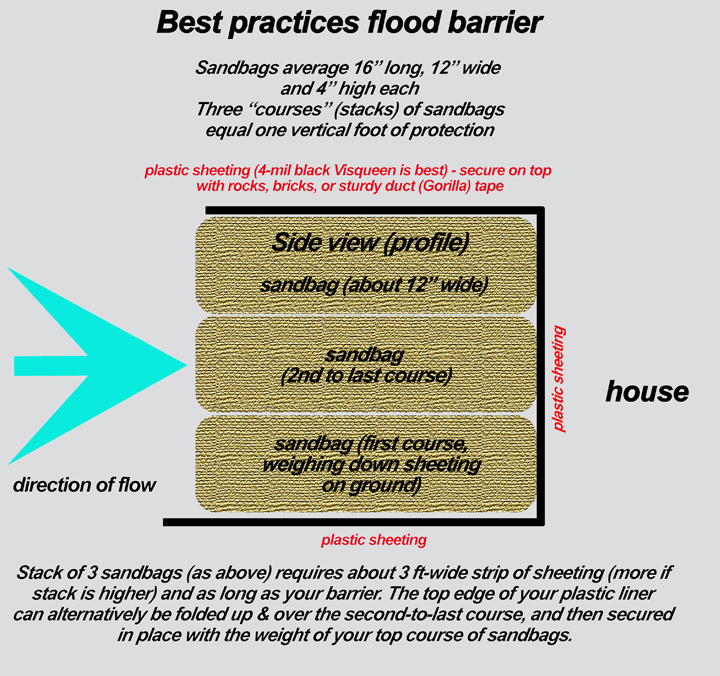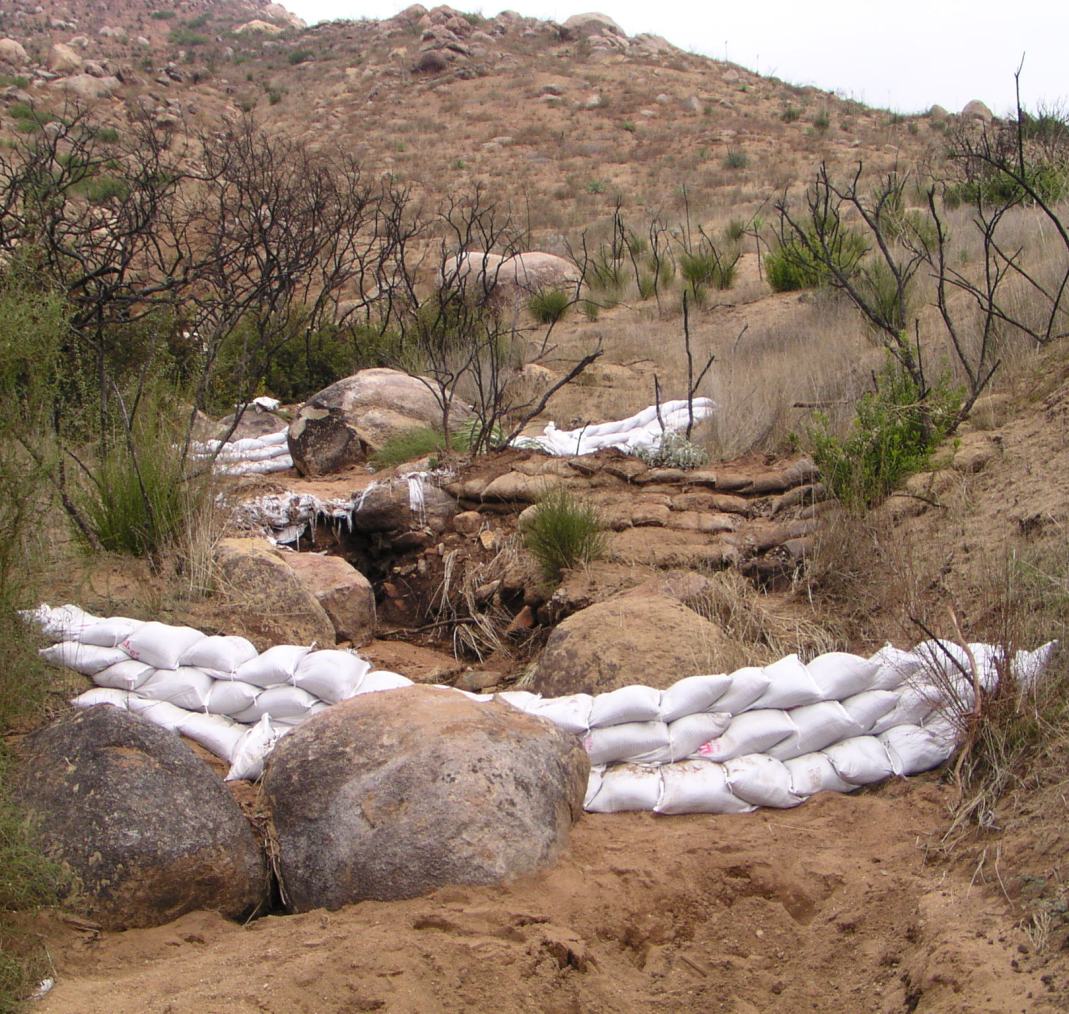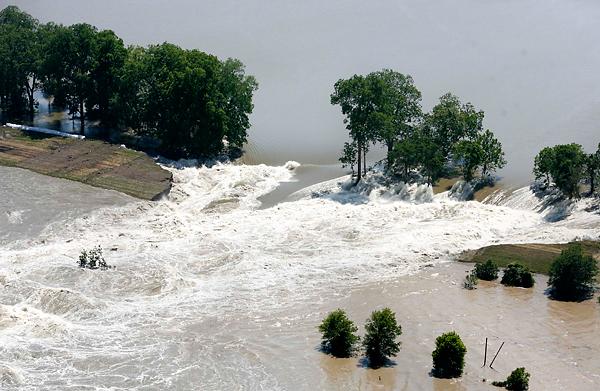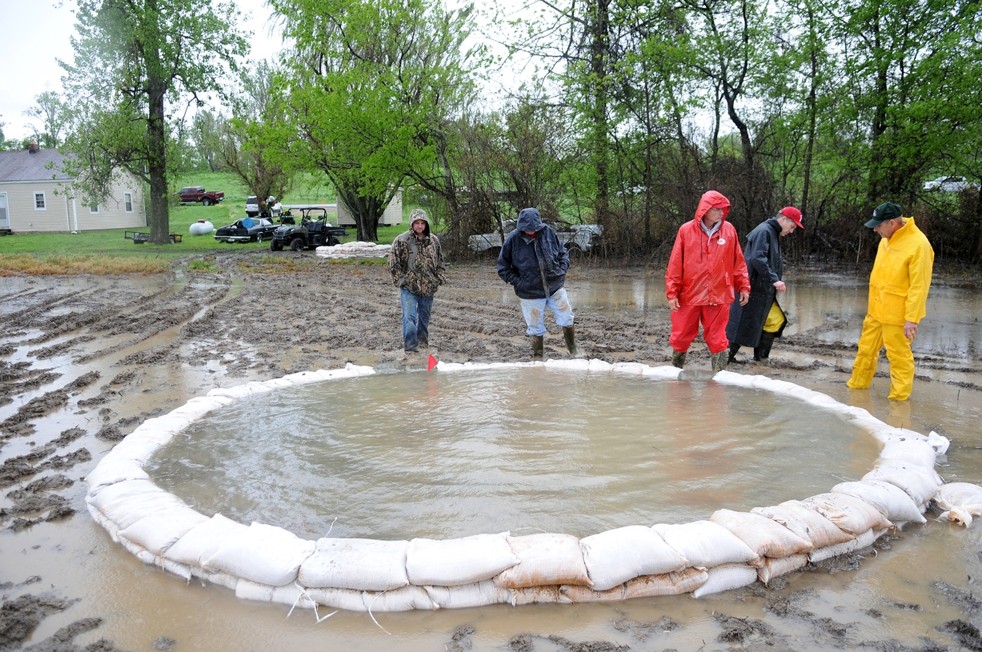Flood
Control |
|
|
Rising Water
Slowly rising water without a strong current or
flow is the easiest to control. This might be
caused by heavy rains that aren't draining fast
enough or properly (and threatening to top your
door's threshholds), or by overflow of streams,
rivers, and irrigation ditches, or burst pipes in
your basement.
There's not much science to controlling this with
sandbags. You simply lay the bags end-to-end,
overlapping them, packing them tightly, and create
a dike that either blocks or "boxes in" the area
you're trying to protect. With filled bags each
averaging about 16" long and 3 - 4" high, you can
secure a doorway (or a basement window) with as
few as three to six bags laid horizontally.
If feasible, you might want to consider boxing in
the doorway, rather than simply stacking the bags
flush against the door. This allows you to
open the door, to control the seepage, and gives
you another line of defense (if necessary, you can
add bags "inside" the box for reinforcement).
If the water continues to rise, you can add layers
("courses") on top of your base. You'll want to
tamp the bags as much as possible (if you don't
have a tamper, you can use whatever's at hand to
hammer them, or at the very least stomp on them).
There'll be seepage from around, under &
between the bags. If the water is still (not
moving, except "up"), you can minimize this
seepage by supplementing with some heavy plastic
sheeting or tarps. Putting the sheeting between
the water and the bags will allow the pressure of
the water against the bags to create some sealing,
but it'll be exposed & subject to tearing.
Putting the plastic or tarps between the bags and
the house is a better idea (click below to
enlarge).

You won't entirely stop the water, but you'll
certainly minimize it. The water that makes it
past the bags can usually be easily controlled. If
you find yourself with a lot of standing water -
more than a mop or a sponge can handle - an
inexpensive pump & 10 - 20 feet or so of vinyl
tubing to discharge the water can move a great
deal of water in a short time. We can provide
these.
If you simply stack the bags flush against the
threshold, then your best bet is to seal the door
with duct tape (sides & bottom), Then tape
some sheeting about a foot or two up the
door, leaving a couple of feet on the ground. Lay
your bags on the plastic, then take the leading
(top) edge of the plastic & pull it up and
over, tucking the free end between the bags and
the door. Finally, give the bags a good kick
or two up against the door.
The advantage of stacking sandbags directly
against a door is that you need fewer bags, and
the seal (depending on how good a job you did) is
almost bomb-proof. The disadvantage is that you
can't open the door until the water goes away, and
you don't have a fall-back position. If possible,
we advise the "box" as described above.
No sandbags? You can do the same with plastic
sheeting (as above) and cinder blocks.
|
Sheeting & Hillside Runoff
Urban areas
In urban settings, heavy rains or broken pipes
& hydrants can cause large volumes of water to
move across impermeable surfaces (paved streets,
parking lots, etc.) and rapidly overwhelm storm
drain capacity - resulting in traffic hazards and
putting curbside residences and businesses at risk
of water encroachment. Sandbags can be quickly
deployed to direct water, or to create a temporary
holding embayment that will slow the runoff down
& allow storm drains to keep up with the flow
until the pumps arrive.
Rural areas
In rural & undeveloped areas, sheeting &
runoff from hillsides can be a huge problem
- especially with the wildfires that have been
plaguing the West the last few summers. Normally,
well-rooted vegetation mitigates the water flow on
hillsides, and soil absorbs a great amount of
water before it enters the streams or rivers in
the canyons and arroyos below.
After a fire, however, the undergrowth is gone,
and the heat of the fire often bakes the clay-rich
soil into a hard glaze ("burn scar") that prevents
absorption of rainfall. What would ordinarily be a
modest rainfall can sheet into waterways, causing
them to overflow their banks. These strong
currents often carry large sediment loads and
destructive debris - including boulders - which
can subvert and overwhelm your sandbag defenses.

The best strategy to control hillside sheeting is
to plan well ahead, before the rain starts, with
the objective of diverting the water (or at least
dissipating its energy). Sandbags can be used to
create check dams in gullies, washes, and arroyos,
creating artificial "holding ponds" to
contain the flow, or to channel off the water
off-site.
If topological features exist like natural
hollows, rockpits, or quarries, sandbags can be
strategically placed to channel the runoff to
these & essentially convert them to detention
basins. If they don't exist, they can sometimes be
created with earth moving equipment (the displaced
soil can then be used to make earthen berms to
divert & contain the water).
When hillsides are steep and slick, be aware that
the pressure of the water can cause the sandbags
to slide; you'll want to trench and use whatever
natural features (dips, rocks, etc.) to ensure
that your line of sandbags doesn't shift. You may
want to stagger the bags to stabilize them and to
prevent movement or shifting.
Once there's a breach in your line of bags, the
weight & pressure of the contained water will
start to wash them out, and create a powerful
surge that will be near impossible to regain
control over. Anything you can do to reinforce
your bags - rope, tie wire, netting, pallets or
boards, etc. - will help.

This can happen suddenly and is where people can
get killed. Once something like this happens, the
best thing you can do is to quickly retreat to
your second line of defense, where you'll either
already have bags stacked in place or - at the
least - you'll have bags filled & ready to
stack. If possible, have a third line of defense
to fall back on as well.
Finally, know your evacuation route in case things
get totally out of hand & you have to make a
run for it.
Plan for the worst, hope for the best.
|
High-Flow Surges
Preventing damage from huge surges (ocean surf,
torrents rushing down ravines, breaches in dikes,
etc.) requires both weight & mass. When loose
sandbags are at risk of simply being washed away,
they can be useful if they are secured together.
Options might include "burritos" (wrapping several
filled sandbags with cyclone fencing - see our Erosion
page) or filling FIBC
bags with sandbags. If you have more time to
plan & implement, You may also want also to
look into gabions
(steel cages made with fence material & filled
with boulders).
Since the damage that can be caused by fast-moving
water coming off hillsides & down ravines is
often compounded by heavy sediment flow &
debris (and even tumbling boulders), you're better
off trying to control it with rigid structures.
Trying to contain it with sandbags may or may
not work, but sandbags are inexpensive, low-tech,
readily filled & put into place, and don't
require anything other than manpower.
If bags are being placed along a river or creek
bank, they'll be subjected to strong lateral
pressure. They should be laid in a minimum
of three wide, and then built up in "stairstep" or
"pyramid" formation (at a minimum, three wide on
the bottom, then two wide on the second layer,
then topped with a single bag on top).
The rule of thumb in pyramid building is that the
width of
the base should always be at least twice &
preferably three times the height. If the
water rises and you need to build higher, you
should broaden the base at the same time.
Your foundation should be laid so it won't move or
shift (preferably not on slick mud). Trenching,
then laying the bags will help secure them.
It's important to fold the openings under the bags
(preferably on the down stream side) - you don't
want the bag's fill material washing out. It's
equally important when laying the bags to overlap
them, butt them together tightly, and minimize the
spaces between them - if there's a significant
flow of water coming from between or under the
sandbags, it can undermine the stack & wash
the bags out.
Sandbags along the banks of waterways are the
first defense. Buildings and houses can be
separately protected with long rows of bags placed
along their lengths to channel the surging
water.
Wells need special attention to prevent
contamination by flood waters. They should be
protected by a ring (or box) of sandbags, several
feet high (see below).

The above photo is actually of a sand boil, which
in some cases can appear hundreds of feet from a
river bank or levee and undermine your working
& staging area.
The same treatment seen here - building a ring or
box of sandbags - can be applied to protecting
water wells, junction boxes, generators, and
other high-value assets.
In high-flow conditions, the power of the water
and the debris (rocks, branches, etc) can dislodge
your sandbag constructions & wash them away in
seconds. You need to use weight, triangular
stacking, and whatever kinds of anchors (metal
stakes, cyclone fencing, etc) to strengthen your
bags.
If possible, have made-up sandbags nearby so that
you can quickly repair whatever breaches occur.
One large pile of bags strategically located can
service several sites.
|
In all cases,
your best strategy is simply to stop
the flow, if you can. Second best is
to divert
it, since it'll probably just keep
coming (and it needs to go somewhere!). Third
is to try to contain
it where it'll do no harm. And
remember that if it's surging, it's not going
to just be water you're dealing with; it may
contain rocks, debris, and a sediment load
which will increase its weight & its
destructive force.
What might start out looking like just a few
inches or a foot of water can rise in minutes
to a level where you lose your options and
evacuation is no longer possible. Consider
what just one inch (1") of rain equals:
| Area |
Gallons
of water |
cubic
feet of water |
Weight
of water (1 gal - 8.33 lbs) |
| 30 x 40
roof |
748
gallons |
100 |
6,231
lbs (over 3 tons) |
| 100' x
100' sq ft |
6,234
gallons |
833 |
nearly
26 tons |
| 1 acre |
27,154
gallons |
3,630 |
113 tons |
| 1 square
mile |
over 17
million |
over 2
million |
over
72,000 tons |
| 5 square
miles |
nearly
87 million |
over
11.5 million |
over
360,000 tons |
Be smart, stay aware of what's happening in
your area, use good judgement, and - most
importantly - know when to back out and
cut your losses.
Additional links: Corps
of
Engineers pamphlet on sandbag use (PDF)
Sandbags can sometimes
be acquired from your local fire station or
emergency response authorities - but they may be
limited in number. Some people have told us -
here in Albuquerque at least - that there's a
limit of anywhere from 10 to 20 bags per
household.
For farmers & ranchers, business, government
& tribal agencies, and anyone else, we can
provide bags in any quantity, from one to
100,000 (larger quantities need to be
pre-ordered). We don't stop at just selling them
to you - if necessary, we'll do whatever we can
to get your bags to where you need them, give
you on-site advice to get you going, and free
you up to worry about other things.
Visit
our store
or contact us directly for prices &
options.
Use this
information at your own risk. No one
associated with New Mexico Dirtbags will have
liability for any loss, damage or injury
resulting from the use of any information,
recommendations, or claims found on this or
any other page at this site. All
information, advice, suggestions and
recommendations are offered in "good faith".
Likewise, New Mexico Dirtbags, its principals
and its employees, will in no way be held
liable for any loss, damage, or injury arising
from the use of any of the products sold or
provided. Purchasers and users of products,
information, and advice made available by New
Mexico Dirtbags are hereby notified that they
are responsible for conducting their own
research, for taking all reasonable
precautions, and for assuming full
responsibility. It's ultimately all on you.
 |
all content
copyright 2012-2023
|
|

